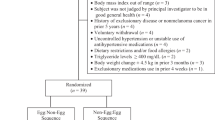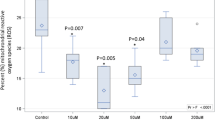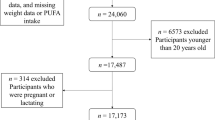Abstract
Objective:
Recent developments in micro-emulsification technology have allowed the fortification of foods with long-chain n-3 polyunsaturated fatty acid (PUFA) without the undesirable fish odour/taste and with reasonable shelf life. The effects of supplementing the diets of people with diabetes type II with a hummus-based dip enriched with long-chain n-3PUFA on plasma fatty acid composition and lipid levels were examined.
Design:
A pre- and post-intervention study.
Setting:
This study was conducted at the University of Newcastle, Australia.
Subjects:
Participants were recruited via advertisements on the University of Newcastle notice boards and in the local newspapers. Following initial response to study advertisements, information statements were mailed out to 29 potential participants. Thirteen participants were eligible and consented to participate in the trial. There were no dropouts as all the 13 participants completed 6-week intervention trial.
Methods:
Free-living male and female subjects with diabetes type II (n=13) consumed the n-3PUFA-enriched dip for a period of 6 weeks. Fasting blood samples were collected pre- and post-intervention for analyses of fatty acids and plasma lipids.
Results:
Following 6 weeks of consuming the enriched dip, all the long-chain n-3PUFA (20:5n-3, 22:5n-3 and 22:6n-3) were significantly (P<0.05) elevated in the plasma lipids. This represented an increase in 20:5n-3 content by 117%, an increase in 22:5n-3 content by 15% and an increase in 22:6n-3 content by 80% over the baseline values before dip consumption. A significant reduction (P<0.05) in the plasma triglyceride levels from 1.93 (1.08–2.09) mmol/l at baseline to 1.27 (0.93–2.22) mmol/l after 6 weeks was also apparent following the consumption of the n-3PUFA-enriched dip. Plasma cholesterol was unchanged; however, low-density lipoprotein (LDL)-cholesterol (2.46±0.21 versus 2.72±0.22 mmol/l, P<0.034) and high-density lipoprotein (HDL)-cholesterol (1.16±0.09 versus 1.22±0.09 mmol/l, P<0.042) were significantly increased following the dietary intervention.
Conclusions:
These results demonstrate that n-3PUFA are readily bioavailable from the fortified dip matrix and alter the plasma lipid profile.
Sponsorship:
This study was conducted without a dedicated fund source.
This is a preview of subscription content, access via your institution
Access options
Subscribe to this journal
Receive 12 print issues and online access
$259.00 per year
only $21.58 per issue
Buy this article
- Purchase on Springer Link
- Instant access to full article PDF
Prices may be subject to local taxes which are calculated during checkout

Similar content being viewed by others
References
Balk EM, Lichtenstein AH, Chung M, Kupelnick B, Chew P, Lau J (2006). Effects of omega-3 fatty acids on serum markers of cardiovascular disease risk: a systematic review. Atherosclerosis 189, 19–30.
British Nutrition Foundation (1992). Task Force on Unsaturated Fatty Acids. London: Chapman and Hall.
Castro IA, Barraso LP, Sinnecker P (2005). Functional foods for coronary heart disease risk reduction: a meta-analysis using a multivariate approach. Am J Clin Nutr 82, 32–40.
Damsgaard CT, SchackNielsen L, Michaelsen KF, Fruekilde MB, Hels O, Lauritzen L (2006). Fish oil affects blood pressure and the plasma lipid profile in healthy Danish infants. J Nutr 136, 94–99.
Dandona P, Aljada A, Bandyopadhyay A (2004). Inflammation: the link between insulin resistance, obesity and diabetes. Trends Immunol 25, 4–7.
Friedberg CE, Jensen MJEM, Heine RJ, Grobber DE (1998). Fish oil and diabetes control in diabetes. Diabet Care 21, 494–500.
Garg ML, Wood LG, Singh H, Moughan PJ (2006a). Means of delivering recommended levels of long chain n-3 polyunsaturated fatty acids in human diets. J Food Sci 71, R66–R71.
Garg ML, Leitch J, Blake RJ, Garg R (2006b). Long chain n-3 polyunsaturated fatty acid incorporation into human atrium following fish oil supplementation. Lipids (in press).
Gregory J, Foster K, Tyler H, Wiseman M (1990). The Dietary and Nutritional Survey of British Adults, Office of Population Censuses and Surveys, Social Service Division. London: Her Majesty's Stationery Office.
Harris WS, Hustvedt BE, Hagen E, Green MH, Lu G, Drevon CA (1997). N-3 fatty acids and chylomicron metabolism in the rat. J Lipid Res 38, 503–515.
He K, Song Y, Daviglus ML, Liu K, Van Horn L, Dyer AR et al. (2004). Accumulated evidence on fish consumption and coronary heart disease mortality: a meta-analysis of cohort studies. Circulation 109, 2705–2711.
Joint Health Claims Initiative (2005). Generic Health Claim for LC n-3 PUFA and Heart Health. Available fromhttp://www.jhci.org.uk/approv/omega.htmAccessed 2 February 2006.
Kolanowski W, Swiderski F, Berger S (1999). Possibilities of fish oil application for food products enrichment with omega-3 PUFA. Int J Food Sci Nutr 50, 39–49.
Kris-Etherton PM, Taylor DS, Yu-Poth S, Huth P, Moriarty K, Fishell V et al. (2000). Polyunsaturated fatty acids in the food chain in the United States. Am J Clin Nutr 71, 179S–188S.
Kris-Etherton PM, Harris WS, Appel LJ (2002). Fish consumption, fish oil, omega-3 fatty acids and cardiovascular disease. Circulation 106, 2747–2757.
Lepage G, Roy CC (1986). Direct transesterification of all classes of lipid in a one-step reaction. J Lipid Res 27, 114–120.
Lewis A, Lookinland S, Beckstrand RL, Tiedeman SE (2004). Treatment of hypertriglyceridemia with omega-3 fatty acids: a systematic review. J Am Acad Nurse Pract 16, 384–395.
Lombardo YB, Chicco AG (2006). Effects of dietary polyunsaturated fatty acids on dyslipidemia and insulin resistance in rodents and humans. J Nutr Biochem 17, 1–13.
Lu G, Windsor SL, Harris WS (1999). Omega-3 fatty acids alter lipoprotein subfraction distributions and the in vitro conversion of very low density lipoproteins to low density lipoproteins. J Nutr Biochem 10, 151–158.
MacDonald-Wicks LK, Garg ML (2004). Incorporation of n-3 fatty acids into plasma and liver lipids of rats: importance of background dietary fat. Lipids 39, 545–551.
Meyer BJ, Mann NJ, Lewis JL, Milligan GC, Sinclair AJ, Howe PRC (2003). Dietary intakes and food sources of omega-6 and omega-3 polyunsaturated fatty acids. Lipids 38, 391–398.
Mori TA, Woodman RJ (2006). The independent effects of eicosapentaenoic acid and docosahexaenoic acid on cardiovascular risk factors in humans. Curr Opin Clin Nutr Metab Care 9, 95–104.
National Health and Medical Research Council (2006). Nutrient Reference Values for Australia and New Zealand Including Recommended Dietary Intakes. (draft report).
Ruxton C (2004). Health benefits of omega-3 fatty acids. Nurs Stand 18, 38–42.
Ruxton CH, Reed SC, Simpson MJ, Millington KJ (2004). The health benefits of omega-3 polyunsaturated fatty acids: a review of the evidence. J Hum Nutr Diet 17, 449–459.
Simopoulos AP (1999). Essential fatty acids in health and chronic disease. Am J Clin Nutr 70, 560S–569S.
Sugano M, Hirahara F (2000). Polyunsaturated fatty acids in the food chain in Japan. Am J Clin Nutr 71, 189S–196S.
US Food & Drug Administration (2004). FDA Allows Qualified Health Claim to Decrease Risk of Coronary Heart Disease Available from http://www.fda.gov/bbs/topics/news/2004/NEW01129.html Accessed 2 February 2006.
Acknowledgements
We are grateful to all participants who gave their valuable time for this trial. Nursing staff at the Health Services of the University of Newcastle are also gratefully acknowledged for collection of the blood samples. This study was conducted without a dedicated fund source (research grant or industry funds).
Author information
Authors and Affiliations
Corresponding author
Rights and permissions
About this article
Cite this article
Garg, M., Blake, R., Clayton, E. et al. Consumption of an n-3 polyunsaturated fatty acid-enriched dip modulates plasma lipid profile in subjects with diabetes type II. Eur J Clin Nutr 61, 1312–1317 (2007). https://doi.org/10.1038/sj.ejcn.1602650
Received:
Revised:
Accepted:
Published:
Issue Date:
DOI: https://doi.org/10.1038/sj.ejcn.1602650
Keywords
This article is cited by
-
Effects of n-3 polyunsaturated fatty acids high fat diet intervention on the synthesis of hepatic high-density lipoprotein cholesterol in obesity-insulin resistance rats
Lipids in Health and Disease (2016)
-
Long‐Chain Omega‐3 Polyunsaturated Fatty Acids in the Blood of Children and Adolescents with Juvenile Bipolar Disorder
Lipids (2008)



